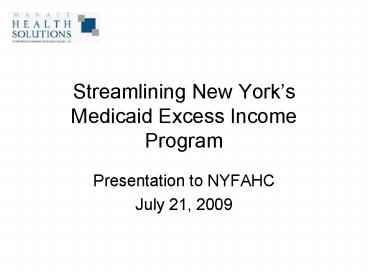Streamlining New Yorks Medicaid Excess Income Program - PowerPoint PPT Presentation
1 / 12
Title:
Streamlining New Yorks Medicaid Excess Income Program
Description:
LDSS: Clinton, Eerie, Onondaga, Schoharie and Westchester Counties and NYC HRA ... Only available to those 65 , blind, disabled, pregnant, children 21 and parents ... – PowerPoint PPT presentation
Number of Views:80
Avg rating:3.0/5.0
Title: Streamlining New Yorks Medicaid Excess Income Program
1
Streamlining New Yorks Medicaid Excess Income
Program
- Presentation to NYFAHC
- July 21, 2009
2
Methodology
- Legal Research and Lit Review
- Interviews with
- LDSS Clinton, Eerie, Onondaga, Schoharie and
Westchester Counties and NYC HRA - Consumer Groups Selfhelp, New York, CIDNY, and
Empire Justice. - Provider VNS-NY
3
Excess Income Program
- Only available to those 65, blind, disabled,
pregnant, children lt21 and parents of children lt
21. - If net income exceeds eligibility level, the
difference between the household income and the
Medically Needy Income Level or the Medicaid
Standard Income Level is the excess income. - Note Medicaid income levels sit well below the
poverty line for most recipients - between 59
and 91 FPL.
4
150,000 New Yorkers Covered Under Excess Income
Program
- Represents 4 of Medicaid population statewide
- 60 of EIP recipients reside in institutional
settings (NAMI) - 40 reside in the community and participate
through one of two options - Spend down
- Pay-in
- 85 are dually eligible for Medicaid and Medicare
5
Spending Down
- Coverage activated after submission of paid or
viable unpaid bills not covered by a third party
to the local district. - Typically monthly, though up to 6 month coverage
available. - Bills can be for covered and non-covered Medicaid
services, equipment prescriptions
co-insurance some over the counter expenses as
prescribed of recipients or legally responsible
relatives. - Bills must be counted in way most beneficial to
recipients. - Complex and varied LDSS practices.
6
Incurring Bills to Meet the Excess Income Amount
Types and Length of Coverage
The excess income amount in the retro-active
period is calculated using the applicants actual
income during that period.
According to officials at HRA, typically
coverage is activated in the system for a year
for NAMI recipients, and institutional providers
are notified at least monthly via roster of each
patients NAMI amount, which must be carved out
of the bill the provider submits to Medicaid for
reimbursement.
7
Paying In
- Federal option.
- Required in NY since 1996.
- Recipients sign a contract.
- Typically monthly, though up to 6 months advanced
payment allowed. - Requires reconciliation at least annually.
- Can be combined with spend down.
- Enormous LDSS variation
- From 6-63 of community EIP recipients outside
NYC pay in. - HRA has different payment site.
- Some districts take personal checks, others
dont. - Relief Repayment in one county.
8
Excess Income Enrollees
Note The limitations of this data are described
in the report endnotes, as well as an
accompanying methodological memorandum, available
upon request.
9
Monthly and Yearly Average Expenditures for
Community Recipients
Note The limitations of this data are described
in the endnotes, as well as an accompanying
methodological memorandum, available upon
request.
10
(No Transcript)
11
(No Transcript)
12
Options for Streamlining
- Buy-In Option
- Buy-In Option with Managed Care
- Plan of Care Option
- Streamline Communications with Providers
- Home Care outside LDSS
- Automate Provider Bill Processing
- Administrative Changes
- Fix WMS sub-system
- Enrollment Center
- Centralize/automate processing
- Reconfigure Eligibility































